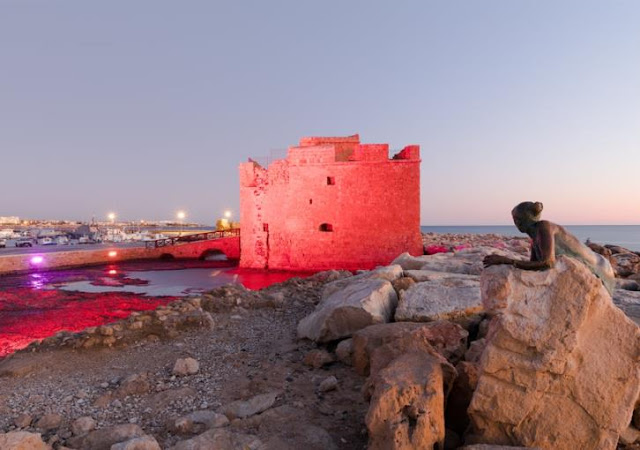Filenews 19 February 2023 - by Dora Christodoulou
The "Girl with the hula-hoop" monopolized interest throughout Cyprus in the previous days, after it was stolen and vandalized by some unconscious people. And it gave everyone the opportunity to refresh in their memory the fact that in recent years works by Paphians and not only artists, were placed in public places that were embellished, contributing to the upgrading of the image of the city. What is perhaps less well known, is that the bronze statue, recently stolen and destroyed, is a "piece" of the large open-air exhibition in Paphos and which is now an open gallery of works of art. The campaign was envisioned and implemented by the people of the Organization for the European Capital of Culture Pafos 2017, in collaboration with artists, under the eloquent title: "Open Museum".
The project-heritage of the Organization for the European Capital of Culture Pafos 2017, entitled "Signs in Time and Space" includes a total of 12 works, which were placed in various parts of the city, thus creating an open gallery in the city.
A geometric marble installation, the "Aspects of Vastness" by Haris Paspallis, the symbol of Cyprus Aphrodite on a rock as the "Other Sun" of Yiota Ioannidou and the red "Poppy" of Andreas Paraskevas that emerges between the Lighthouse and the sea, are three of the projects that have been installed first in strategic points of the city, on the western coastal front of Kato Paphos, giving it another interesting perspective and being much photographed spots and works.
The interventions of the artists who have already installed works within the framework of the same project are complemented by Andreas Makariou, Umit Inatcsi and Dimitris Makariou who created sculptures and visual works in open spaces, giving a new dimension to the open culture factory as an idea and further development in the philosophy of the "Open Museum". The ambition with these projects is to put Paphos on the map of those cities with interesting and charming reference points for both residents and visitors.
The artist, Yiota Ioannidou, points out that this effort, unique in Cyprus, concerns the search for the cultural tradition of myth and archetypal historical memory and their transformation into artistic interventions in space, so that they become the leaven for the creation of a permanent "Contemporary Open Museum of Art" with new signs and semiotics.
"The artists, the direct relationship with the general public does not have it", she observes. " There is usually a limited audience in galleries and museum spaces. An audience that operates, either with the lever of its need to admire, or to see and experience what the work emits. There is a big difference in a work that is exhibited in a public space and in an indoor space, galleries, museums. For me, galleries and museums are research spaces where you talk more with colleagues or art experts or with people who are initiated in artistic pursuits. You can have an expert dialogue.
But when you are in the public space, things change radically. You have the cultural reality to deal with. You go to put your hand in a real space, so the dialogue you open is not with the experts, it is directly with the general public and with the transverse power. When you do an exhibition in a gallery, in a museum, the people of art have an ideological view of art each and a position limited to the objectively correct. So the dialogue is not hedonistic, it does not have the hedonic element. While with the world there is this relationship. Abroad, art for the public is something of a natural phenomenon, perhaps even necessary."
Her own idea, emphasizes Mrs. Ioannidou, is based on the cultural stratification of place and space in particular. What concerned me from the moment the idea of the sculpture began, she explains, was whether it could be integrated into the lives of the inhabitants of this city:
"When you start from a stimulus that for us Paphites could be the Medieval Castle, next to the port and the archaeological site, you have a plan of creation. This determines your own artistic discourse in relation to the final image of the work. In the course of implementation, random events many times determine the final result. And where you say as a creator it is completed, you hand it over to his world."
The area next to the Medieval Castle, within an archaeological site, already has enough energy, able to support its importance, says Yiota Ioannidou.
"The information is many, the experiences are so much", she emphasizes. " It is the city where I was born and the place where I first observed visually. One understands when one finds himself in the place where the sculpture of modern Aphrodite was installed next to the Medieval Castle, the sea and the rest of the archaeological site, that the energy of the work is outside the project. That is, what the work does to you matters, not its carving, or its detail or its material. You don't say what a nice carving. That is, it surpasses its material. And you feel the energy behind you, next to you, you feel your senses affected."
The "open museum" of Pafos, however, points out the visual artist Yiota Ioannidou, essentially remains in limbo, while the great goal she wanted to serve is not fulfilled: And this was none other, she observes, than to have a timeless continuation of that effort that began and flourished while Pafos was the European Capital of Culture.


